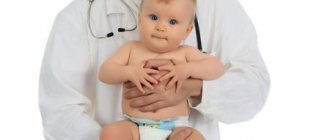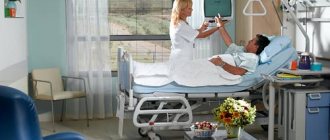Vomiting and diarrhea are the body's defense reaction to toxins or poisons from food. These are the phenomena that accompany food poisoning. But such symptoms can also be accompanied by various other diseases, for example, intestinal infections or digestive disorders. In this case, the patient will also experience abdominal pain, dizziness, fever, and loss of strength. This condition requires medical attention, especially if observed in a child. But diarrhea and vomiting in an adult that occurs some time after eating spoiled or low-quality food can stop on their own.
Diet for vomiting and diarrhea
After normalization of the condition, you need to satisfy your hunger.
Light food is suitable for this: baked apple, crackers with tea, banana. If no new attacks of diarrhea or vomiting are observed, you can switch to an expanded diet. Food is taken in small portions, but often - 5-6 times a day. The diet must be followed for up to 2 weeks for the digestive system to recover completely. During the rehabilitation period it is allowed to use:
- low-fat varieties of fish, boiled or stewed meat;
- boiled eggs;
- crackers, biscuits;
- steamed or boiled vegetables;
- bananas, apples;
- low-fat cottage cheese, kefir;
- natural yogurt;
- porridges, puddings, cereal casseroles;
- herbal teas, compotes, fruit drinks, jelly.
You cannot eat smoked products, sausages, marinades, pickles, or hot spices. Alcoholic drinks are prohibited. During the diet, it is recommended to refrain from consuming milk, nuts, legumes, and confectionery.
Diagnosis of the disease
Diarrhea that occurs at night suggests an organic functional problem rather than a disease substrate.
It is also important to determine the color and consistency of the stool. The presence of mucus and blood indicates an inflammatory or tumor etiology of intestinal disease.
Black, tarry discharge with a loose consistency is a symptom of bleeding from the upper gastrointestinal tract.
Accompanying vomiting and diarrhea suggests inflammation of the gastric mucosa. Such symptoms can occur without an increase in temperature.
The appearance of diarrhea during or after the use of antibiotics requires special investigations.
The combination of diarrhea with milk consumption is a symptom of lactase deficiency, and the consumption of nuts, fruits, chocolate or shellfish is a symptom of an allergic reaction of the gastrointestinal mucosa.
Vomiting is a symptom that involves the involuntary emptying of stomach contents through the mouth. It can occur with diseases of the gastrointestinal tract, as well as due to causes outside the gastrointestinal tract.
Vomiting pathogenesis is complex and multicomponent based on the impulse, the most important element is the vomiting center located in the medulla oblongata (in the lower part of the chamber). Through autonomic fibers, the center receives impulses from receptors for visceral sensory nutrients and toxins, as well as receptors located in the brain stem that respond to changes in the chemical composition of the blood.
The act of vomiting is preceded by a deep breath, which lowers the membrane, followed by closure of the glottis and contraction of the pyloric stomach, relaxation of the shaft and lower esophageal sphincter. Vomiting is the result of cyclic contractions of the abdominal muscles, which increase intra-abdominal pressure transmission to the stomach wall.
The first thing is to distinguish vomiting from the retreat of eaten food and salivation. The coexistence of nausea suggests disease of the stomach or duodenum. If vomiting occurs due to diseases of the central nervous system, nausea may be absent.
Diet for vomiting and diarrhea
A diet for diarrhea and vomiting helps to quickly restore the body. The diet includes natural foods high in vitamins. Food is taken in small portions, but very often, up to 6-7 times a day. The diet should last about 2 weeks, usually during this time the gastrointestinal tract has time to recover almost completely.
During the rehabilitation period after vomiting and diarrhea, you can consume the following products:
- Lean meats and second broths.
- Boiled lean fish.
- Boiled eggs.
- Steamed or boiled vegetables.
- Biscuits or crackers.
- Apples and bananas.
- Low-fat milk and cottage cheese.
- Bifidokefir.
- Cereal products – porridges, puddings, casseroles.
It is not recommended to consume sausages, smoked products, pickles, marinades and dishes that are richly flavored with spices. The consumption of alcoholic beverages and even beer is strictly prohibited.
When to go to hospital
There are a number of indications when diarrhea, as well as an unpleasant feeling inside the stomach, must be treated in a medical facility. Tactics are aimed at preventing death, as well as the development of multiple complications for the body. You should call a doctor under the following predisposing circumstances:
- The child got sick. If an adult has vomiting and diarrhea, it is easier to treat such a patient compared to the situation when the disorder is observed in a child.
- Vomiting and diarrhea were complicated by an increase in body temperature to high levels.
- A patient experiencing intestinal distress has diabetes mellitus.
- The family of a patient suffering from vomiting and diarrhea has relatives with viral hepatitis.
- Feces are dark in color and have a tar-like consistency.
- The condition, which is characterized by an intestinal disorder, has affected the ability to urinate - urinary retention has developed or when attempting to urinate, it is absent.
- Vomiting and diarrhea occurred after a recent trip to exotic countries.
You cannot rely on chance if the disease persists for 3 days in a row, and there is no tendency to improve. By contacting a specialist earlier, you can count on a full recovery in the near future.
Treatment methods for the condition
If stomach cleansing occurs rarely and is associated with overeating or taking medications, be careful about your food intake. Sudden reflexes for no apparent reason require examination to make an accurate diagnosis. Seek advice from a therapist. The doctor will examine the symptomatic picture and, if necessary, refer you to specialists - a neurologist, gastroenterologist, or surgeon.
It is important to maintain a drinking regime! To prevent dehydration, you need to drink water-salt solutions: Regidron, its analogues. The instructions describe how to take the medication correctly. Course - 2-3 days.
To remove toxins in case of poisoning or infection, it is recommended to take sorbents. Polysorb, Enterosgel and their analogues have a good effect.
In case of vomiting caused by the use of toxic substances or medications, gastric lavage is performed. To do this, use a weakly colored solution of potassium permanganate or water in a large volume, followed by pressing on the root of the tongue.
Loading …
When you contact a doctor, a diagnostic examination will be prescribed to determine the causes of the above symptoms.
Table 1. Diagnostic procedures
| Name | Description of the method |
| Palpation | The doctor examines the patient's abdominal area with his fingers. At the same time, the nature of the pain that occurs during this stage of the examination is determined, on the basis of which a preliminary diagnosis is made. To clarify it, standard tests of blood, urine and feces are prescribed. |
| Coprogram | This diagnostic method helps determine the presence of infections, their type and specific pathogens. Stool samples are also examined for the presence of parasites. It is known that the causes of diarrhea and vomiting can be roundworms, lamblia and pinworms, which easily enter the body with low-quality or unprocessed food, from dirty hands and other sources. In deciphering the coprogram, the density and appearance of feces, coloring, the presence of a specific odor, particles of undigested food and various discharges (purulent, bloody) are analyzed. |
| Hydrogen breath test | Using this diagnostic method, a specialist can obtain information about the presence of bacteria, malabsorption of minerals and nutrients, as well as the prevalence of bacteria in the small intestine. |
| Colonoscopy | The examination is carried out using a fibrocolonoscope, and the inner surface of the intestine is examined up to the colon. The device is inserted through the rectum. |
| Esophagogastroduodenoscopy (EGDS) | Using this method, a detailed examination of the internal linings of the esophagus, stomach, and duodenum is performed. The study is carried out using a gastroscope inserted into the esophagus through the oral cavity. |
| Ultrasound examination (ultrasound). | This diagnostic method allows a specialist to give an objective assessment of the condition of the gastrointestinal tract and determine the presence of pathological processes that caused diarrhea and vomiting. |
| Irrigoscopy | This diagnostic method is intended for a detailed examination of the colon. The doctor receives images that clearly show defects in the mucous membranes. The results of irrigoscopy completely eliminate the chance of medical error. |
| Sigmoidoscopy | The diagnostic method is aimed at examining the rectum and sigmoid colon. Using a sigmoidoscope, pathologies such as tumors, fissures, polyps and hemorrhoids are detected, which can also cause diarrhea. |
To identify the clinical picture of negative symptoms, methods of questioning and studying the patient’s medical history are used. The doctor palpates and taps the abdominal area with special instruments. This manipulation allows you to identify painful places where the problem is localized.
After a general examination, the specialist prescribes laboratory tests for the patient:
- Coprogram. A small amount of stool is taken for analysis. Their appearance, structure and composition are studied under a microscope. Using this method, diseases such as pancreatic enzyme or liver failure are detected.
- Biological analysis of stool. Gives an idea of possible diseases of the gastrointestinal tract. Can identify intestinal dysbiosis or infections that have caused weakening of the muscular walls of the colon and led to diarrhea or vomiting.
- General blood analysis. Allows you to identify hidden infectious diseases and acute stage diseases, such as cholecystitis, colitis, appendicitis and allergies.
- Blood chemistry. Allows you to identify serious chronic diseases such as acute pancreatitis, hepatitis or cholecystitis.
- Hematological examination. Detects disturbed electrolyte balance and warns about the development of diseases such as uremia and adrenal insufficiency.
- Ultrasound echography of the abdominal organs. Allows you to detect pathologies of the gallbladder and biliary tract, pancreas and kidneys.
- Esophagogastroduodenoscopy. Problems with the digestive tract and duodenum are identified.
- CT scan. Identifies pathologies that provoke vomiting. The procedure provides a vision of a possible brain tumor.
Medicines that affect motor skills
Correction of intestinal motility is a guarantee of eliminating diarrhea in a fairly short time for any cause of the pathological process. A positive result is possible due to the slowing down of the movement of the food bolus directly in the intestinal lumen, minimal mucus production and weakening of the tone of the walls.
Popular medications with this effect include:
- Imodium plus. The product is supplemented with an antifoam agent – Simethicone. The result is effective adsorption of intestinal gases, elimination of the feeling of fullness and bloating, and painful spasms. The medicine is introduced into the treatment regimen for adolescent children. 12 hours after stool normalization, therapy is stopped.
It is advisable to drink rehydration medications for diarrhea: Regidron, Gastrolit. They restore the water-salt balance, normalize the levels of sodium, potassium and their salts.
Folk remedies for diarrhea and vomiting
Some people are wary of pharmaceutical drugs and prefer medicinal herbs. In this case, you need to know what can be treated. In order to relieve nausea and vomiting, you can give the patient tea with mint or lemon balm, to which a slice of lemon is added. This drink is a good tonic, relieves inflammation in the stomach and intestines, and also reduces muscle tension.
This drink can be given to patients of all age groups, little by little, but very often. Yarrow herb can help with diarrhea. This medicinal herb has a disinfectant and bactericidal effect. A decoction of plant materials will very quickly stop diarrhea and return a person to a normal state.
Before treating diarrhea or vomiting yourself, you should consult your doctor. The following will help relieve symptoms of poisoning:
- Pomegranate peels. Grind the dried raw materials. Pour 1 tbsp. l. a glass of boiling water, bring to a boil, cool. Take half a glass 20 minutes before meals, 2 times a day. The course of treatment is until the symptoms disappear.
- Ginger tea. Pour in 1 tsp. dry ginger with a glass of boiling water. Leave for 20 minutes. Drink 1 tbsp throughout the day. l. every 30 minutes.
- Carrot puree. Boil 4 carrots in their skins, peel, mash with the addition of boiled water. Use 3 tbsp of thick puree. l. 4 times a day until the condition improves.
pharmachologic effect
Anti-nausea tablets differ in terms of pharmacodynamics in the capacity of special components that eliminate the symptom of nausea. Mostly it is dimenhydrinate (chloroteophylline salt). By acting on the central nervous system, it inhibits the activity of the vestibular apparatus in relation to dizziness, dulls the gag reflex, and calms.
After administration, this substance usually begins to act after 15-30 minutes, and the duration of its effect lasts for 3-6 hours. These indicators are usually associated with the substances that make up a particular drug.
Indications and contraindications for use
As you can see, anti-nausea medications are used depending on the causes or pathologies that cause it. When it is poisoning, toxicosis, traveling in transport, etc., you can use the medicine until the symptom of lightheadedness that appears is completely eliminated. Those who love to travel and travel are simply obliged to have such tablets with them.
Contraindications to the use of tablets that prevent nausea include the body’s failure to accept the active substances that are present in their composition, mainly dimenhydrinate, dimenhydramine and chloroteophylline.
Certain tablets are not indicated for use by pregnant women, especially in the early stages of their pregnancy. True, there are medications that are acceptable for use. However, it is up to the doctor to decide whether to drink them or not.
No matter what they say about the harmlessness of the drug, it should be used with caution for infants. If necessary, it is better to use traditional methods. After all, the cause of nausea in a baby may indicate a more serious problem.
Therapy with antibacterial drugs
Antibiotics are indicated for mandatory use if intoxication has developed against the background of an intestinal infection. The principles of their action are different, so you need to approach the choice of the drug responsibly. This group includes the following medications:
Phthalazole is an inexpensive drug belonging to the group of sulfonamides that quickly improves the condition of acute dysentery and enterocolitis. The visible result is noticeable after a couple of days, which are necessary to suppress pathogenic flora.
Despite the attractive price, it is advisable to refuse treatment with tablets if diseases of the liver, kidneys, or hematopoietic system are detected. During pregnancy, Fthalazol is prescribed exclusively at the end of the first trimester, when the benefit to the mother is disproportionately greater than the harm to the fetus. A small child can be given these inexpensive anti-diarrhea tablets at an early age.
Furazolidone is a drug from the nitrofuran group with a characteristic yellow color. Used in treatment regimens for food poisoning, infectious diarrhea, salmonellosis, and dysentery. Complete disappearance of symptoms occurs after two days only if the body is exposed to viruses or bacteria.
It is prescribed to children starting from a young age, to expectant mothers - in case of emergency. If Furazolidone is prescribed during lactation, the child is transferred to artificial feeding.
Levomycetin - a medicine with the active ingredient Chloramphenicol is inexpensive, but effectively copes with diarrhea, unless it is of a viral or fungal nature. Often the tablet is taken once, getting improvement after a maximum of 4 hours. In the absence of pronounced positive changes, you should seek medical help. Due to the risk of developing the dangerous “gray syndrome”, the cheap drug is not prescribed to pregnant women, nursing mothers and young children.
Enterofuril is a medicine to suppress any microflora; it does not cause an imbalance in the body due to its antibacterial activity only in the intestinal lumen. Children under 7 years of age are given a suspension, selecting the dosage according to the table given in the instructions.
Diarrhea and vomiting in an adult: how to treat and how to stop |
Diarrhea and vomiting are common symptoms for many diseases. Finding the root cause on your own is almost impossible. If an accurate diagnosis is required, then to make it you need to go to the doctor, get tested and wait for the results. The problem cannot be ignored - it threatens to dehydrate the body, and this is very dangerous. Therefore, you should know when an adult has diarrhea and vomiting, how to treat such a condition and what to be wary of.
The appearance of diarrhea and vomiting is most often associated with indigestion. In fact, this is only partly true.
Nausea and diarrhea can have a variety of causes. Here is just a small part of them:
- Diseases caused by fungus or parasites.
- Food poisoning.
- Abuse of alcohol and fatty foods.
- Pregnancy.
- Severe anxiety and stress.
If diarrhea and vomiting occur simultaneously due to a viral infection, then such a patient can infect everyone around him. Even after full recovery, he still must remain in quarantine for at least several days.
It is not difficult to contract infections that are accompanied by nausea and diarrhea. There are several ways to do this:
- Tactile contact with contaminated objects. The person may then somehow put their hands in their mouth without washing them first.
- Consuming drinks or food contaminated with the pathogen.
- Direct contact with a sick person, sharing dishes or other household items.
You can carry out a number of procedures, observing their correct sequence. First, the patient needs to limit himself to food for 12 hours, and ideally for the whole day. You can drink, but only green tea, clean water and compotes. Liquids should be taken in modest portions every 20 minutes.
If the cause of indigestion is poor quality food, it is recommended to do gastric lavage. At home, it is allowed for almost everyone, but only if the patient is over 3 years old.
When the baby is unwell, the only option for the development of events is transfer to a hospital.
When the rinsing is completed, the patient will feel hungry after some time. It is best to continue fasting, but a ripe banana or baked apple is quite a dietary food so as not to cause a new attack of vomiting.
You should return to your usual menu gradually, eliminating fatty foods.
Diarrhea without fever and vomiting is less common in adults. In such a situation, it is allowed to take activated carbon or Smecta. These funds are enough to normalize a person’s condition in a few hours.
Liquid diarrhea, which is predominantly water, can be relieved with rice water and raisins. To prepare it, take two tablespoons of rice, one spoon of raisins, and then simmer it all over low heat. The resulting decoction is filtered and drunk at intervals of half an hour.
Pharmacy drugs are good in cases where the problem needs to be dealt with urgently. The main antiemetic is Cerucal. Metoclopramide contains a similar active ingredient, but is cheaper.
This drug comes in two forms: tablets and injection solution. Mild vomiting is effectively stopped with the help of tablets. To get the effect you will have to wait half an hour, but it will last about 6 hours.
When the only concern is diarrhea and nausea in an adult without fever, and there are no other symptoms, activated charcoal, Imodium or Smecta are suitable medications. Their main effect will not only help stop endless trips to the toilet, but will also relieve intestinal inflammation.
https://www.youtube.com/watch?v=5KGetWmfguU
Medicines should be taken only in the dosage prescribed by the doctor or indicated in the instructions. Exceeding will not help you heal faster, but it increases the risk of side effects.
Folk remedies
Some people have prejudices about pharmaceutical drugs. They prefer medicinal herbs.
Nausea and vomiting are relieved by tea with mint or lemon balm. You can also add a slice of lemon there. The resulting drink relaxes the stomach muscles and relieves intestinal inflammation. It is also suitable for all age groups, but even it should not be overused.
Yarrow herb helps with diarrhea. It has bactericidal and disinfectant properties. The taste of the decoction is very bitter, so children do not like it and often refuse to drink it.
Adults can take two tablespoons every half hour, children - a teaspoon.
Sometimes symptoms of stomach upset appear after returning from exotic countries. Then you need to go to a doctor immediately for treatment. This is one of the signs of infection with something very specific.
Doctor intervention may be required in a number of cases:
Nausea, vomiting, and diarrhea persist for more than a day.
- The temperature rose and abdominal pain appeared.
- Diarrhea lasts 3 days without visible improvement.
- Symptoms of dehydration appeared - weakness, dry mucous membranes, blue discoloration of the skin and anuria.
- The stool has blood in it or a tarry appearance.
- Abdominal pain persists even after vomiting or going to the toilet.
- The patient has insulin-dependent diabetes.
- Vomiting prevents the patient from taking medications on which the patient’s life depends.
Diet menu
When food and water no longer cause rejection, you can think about a diet. The diet should be dominated by foods high in vitamins.
You will have to eat in small portions, but very often. In total, 6-7 meals are planned for the day. And this continues for two weeks. This is exactly the period required for the restoration of the gastrointestinal tract.
The following products are allowed:
- Meat with minimal fat content.
- Low-fat fish varieties.
- Boiled eggs.
- Boiled vegetables.
- Crackers without spices or sugar.
- Apples and bananas.
- Cereal dishes - porridges and puddings.
Sausage products, pickles, marinades, smoked meats and anything else containing a large amount of spices are prohibited. Alcoholic drinks, including beer, should also be excluded from the diet.
Loading…
Description of drugs
The main goal of medications that prevent nausea is to soften its manifestation, restore the normal functioning of the gastrointestinal tract, and relieve the patient of cramps and pain, the very disease that caused the occurrence of such a symptom. Therefore, each drug has its own direction:
For gastrointestinal pathologies
- Cerucal is one of the most used antinausea and antiemetic drugs. Perfectly restores the gastrointestinal tract. Produced in tablets and solution for injection;
- Xylocaine spray is a remedy that relieves pain and relieves the urge to vomit;
- Buscopan - has a local antispasmodic and choleretic effect, prescribed for biliary and renal pathologies, gastritis and ulcerative colitis;
- Riabal is an antispasmodic, used to treat gastritis, ulcers, as well as cholecystitis and inflammation of the bladder;
- No-spa is a fairly well-known antispasmodic agent. It especially helps with inflammation of the gallbladder and urinary system;
Prevention of complications
The indomitable gag reflex in children is eliminated with centrally acting drugs. Medicine for food poisoning after first aid corrects water and electrolyte disturbances. Some patients experience chronic bleeding during exacerbation of gastrointestinal diseases:
- Antihistamines and anti-inflammatory drugs - “Promethazine hydrochloride” and “Dimenhydrinate”.
- When vomiting against the background of impaired intestinal motility, it is rational to prescribe anticholinergic drugs (Scopolamine).
- Phenothiazine derivatives, haloperidol are drugs for poisoning with mild vomiting and nausea. The drugs have side effects - parkinsonism, decreased blood pressure (hypotension), and a calming effect.
- Metoclopramide is a selective dopamine antagonist prescribed for vomiting due to alcohol poisoning. The drug is used after alcohol intoxication, before chemotherapy if a tumor is suspected.
- Cisapride, which has a peripheral antiemetic effect, is considered a successful drug.
- Vomiting after chemotherapy is eliminated with Dronabinol and Ondansetron. When azithromycin is combined with the above drugs, gastric paresis is treated.
Metroclopramide
Dronabinol
Flora restoration
In addition to stopping diarrhea, it is important to take care of the correct balance of bacteria in the intestines after illness. For this purpose, it is recommended to drink the following medications for diarrhea:
- Bionorm. The drug is an additional source of dietary fiber that helps normalize the motor function of the gastrointestinal tract and eliminate toxins. The product simultaneously acts as a sorbent and prebiotic.
- Baktisubtil. Tablets that produce useful organic acids. The intestinal microflora is quickly brought back to normal. The medicine is especially indicated for high bacterial growth.
- Linux. Containing three types of beneficial microorganisms at once, the capsules have a complex effect on the digestive system. The presence of lactobacilli, enterococci and bifidobacteria allows you to immediately improve the health of the large and small intestines.
- Hilak forte. The result of therapy is the proliferation of beneficial bacteria in the digestive system and improvement of the secretory function of the stomach.
- Lactofiltrum. The action is similar to the previous position, but there is a contraindication in the form of intestinal obstruction.
First aid
Any intoxication of the body is accompanied by a number of actions with which the patient should feel better:
- It is important to induce vomiting in the patient by all available means. The best option is a solution of potassium permanganate with warm water.
- In case of poisoning with chemicals or other substances, gastric lavage is performed using a specialized probe and only with the hands of a specialist.
- The patient should drink plenty of fluid.
- In case of food poisoning, activated carbon will come to the rescue, with the help of which you can alleviate the condition.
- Medicines prescribed by the doctor will help restore the intestinal microflora.
Note! For any type of poisoning and for any degree of complexity, it is necessary to call a team of doctors. Only they will be able to establish an accurate diagnosis and prescribe medications that will relieve unpleasant consequences.
If there is severe vomiting, liquid is given to the victim in small doses. This is what allows you to eliminate complete dehydration of the body and restore the balance of substances.
For weight loss
Often, the method of artificial emptying through the mouth is used by girls who want to lose weight. Timely and systematic elimination of food from the stomach will help eliminate extra pounds. However, experts consider this method dangerous, as it can cause problems in the digestive tract, mental disorders, and also leads to exhaustion of the body.
Despite the fact that artificial reflex emptying is very harmful to health, it has found its use in many women.
One of the favorite methods is to use ordinary salt water with a solution of potassium permanganate, as well as hydrogen peroxide.
Among the drugs used for the same purpose, we can note:
These products must be purchased with a prescription to avoid dangerous consequences.
What it is
Chills are a condition in which a person feels shaking inside the body. He cannot warm up; even warm clothes, shoes, and hot tea do not help. Accompanied by chills, malaise, loss of strength. The person may feel very sleepy. He either falls asleep immediately or cannot fall asleep for a long time.
Nausea is discomfort in the epigastric region, which is accompanied by increased salivation and a state of lightheadedness. Often with this condition, the complexion changes, the person loses the ability to navigate well in space, and wants to sit down. Nausea is often accompanied by dizziness, a desire to vomit, and stomach pain.
In most cases, nausea is associated with diseases of the digestive system and bad eating habits. It can be one-time, for example, it occurs after overeating, alcohol abuse, or eating poor-quality food. Periodic and constant nausea are symptoms of serious health problems.
At-risk groups
High-risk groups include:
- Elderly people. The older a person is, the less his body resists various microorganisms from the external environment.
- Infants. Their immunity is not yet fully developed.
- People with AIDS, diabetes, and cancer patients taking chemotherapy. These diseases reduce the body's ability to fight invading microorganisms.
- Pregnant women.
Age and general health - these factors determine whether you will get sick from eating contaminated food.
If the poisoning was caused by products that contained nitrates or pesticides, it is necessary to take medications to help the liver and intestines.
Symptoms
Since diarrhea and nausea can be signs of various pathologies, when making a diagnosis, doctors always pay attention to the accompanying symptoms.
Poisoning
Severe abdominal pain usually indicates food poisoning. This condition is also accompanied by diarrhea, vomiting, and general weakness. The patient has the following symptoms:
- Dry mouth.
- Sweating.
- Weakness.
- Dizziness.
- Headache.
- Hand trembling.
In some cases, in case of poisoning, diarrhea is only a consequence of an increase in the content of toxins in the human body.
Depending on the type of toxin, accompanying symptoms may vary.
- When poisoned with antipyretic drugs, the patient develops diarrhea, feels sick, and becomes weak and unconscious.
- Alcohol intoxication is accompanied by darkening of the eyes, loose stools disappear within 24 hours.
- Mercury vapor poisoning causes a metallic taste in the mouth, along with bloody diarrhea and bleeding gums.
Only a specialist can make an accurate diagnosis based on symptoms.
Infection
With bacterial damage to the intestines, the diarrhea becomes watery; in particularly difficult cases, it may contain a large amount of mucus and bloody streaks. The disease is accompanied by severe cramping abdominal pain and fever.
The viral disease is accompanied by an upset stomach, in which the frequency of loose stools reaches 5-6 times per day, the patient experiences nausea and frequent vomiting. In this case, the temperature may rise to 39ºC with the appearance of severe pain in the lower abdomen, sore throat, and runny nose.
Functional disorders
If the gastrointestinal tract is disrupted in an adult, vomiting and diarrhea can become chronic if there is no treatment. Additionally, such patients complain of heartburn, belching, flatulence, bloating, and a feeling of heaviness in the stomach.
Binge eating
When overeating, symptoms similar to poisoning may develop: nausea, vomiting, diarrhea, weakness. The difference between this pathology and poisoning is that after vomiting, significant relief occurs. If a person does not eat for some time, the functioning of the gastrointestinal tract is restored without taking medications.
What not to do?
Some actions when a patient has chills can only worsen his situation:
- Under no circumstances should you try to reduce the patient's body temperature with cold water or ice.
- Do not remove blankets or warm clothes from the patient.
- Under no circumstances should the patient be allowed to rise to his feet or move around.
- Cold drinks are also strictly contraindicated.
The victim of poisoning, which is accompanied by chills and diarrhea, needs to create the most comfortable conditions that will contribute to his speedy recovery.
A little more about drinkers
There are different ways to deal with drunkenness. If you use herbs, the effect can be obtained quite quickly. The simple herb thyme will not only cause vomiting, but will also develop a persistent aversion to alcohol. Traditional medicine advises infusing thyme and treating an alcoholic with the tincture before the feast. Thyme in combination with alcohol guarantees vomiting. And disgust too. It would seem that the issue is resolved! Brew yourself some thyme and offer it to the drinker! However, not everyone can use herbs. Like medicines, herbs have contraindications. Thyme is not allowed:
- for pathologies of the heart and kidneys;
- during pressure surges;
- taking hormones;
- with parkinsonism.
Herbs are not at all harmless, don't forget. In other sources, in order to cause a persistent aversion to alcohol, they recommend drinking hellebore, hogweed, etc.
Please, be careful! Both hellebore and hogweed are poisonous herbs!
We don’t know whether they will only cause disgust. Maybe a disgust for life? Don't take risks, brew tried and tested herbs that you know well.
Types of poisoning
Poisoning itself in most cases is caused by the intervention of foreign substances and their entry into the human body. It is simply impossible to predict where exactly danger awaits, therefore it is important to insure yourself with at least knowledge about the types of poisonings and their possible sources:
- Food poisoning is the most common type of disease caused by eating low-quality foods or individual intolerance to food elements. It also occurs when eating foods contaminated with harmful bacteria.
- Chemical poisoning, putting every housewife at risk of infection. Most often it manifests itself due to the ingestion of detergents and cleaning products, household and other chemicals.
- Poisoning by pesticides used to control insects in garden plots.
- Plant poisonings are caused by eating poisonous berries, fruits and plants.
- Drug intoxication resulting from improper use of medications or individual intolerance to their components.
- Carbon dioxide poisoning, which occurs in case of emergencies, fires and poor ventilation of the room.
Note! Diarrhea, fever, nausea and weakness are the most common symptoms indicating the onset of intoxication. Despite this, there are other signs of the disease that require immediate contact with a specialist for subsequent treatment and rehabilitation.
Causes of the symptom complex
Most often, the combined appearance of nausea, chills and weakness is a sign of intoxication syndrome due to infection. Pathogenic microbes secrete toxic substances, under the influence of which such manifestations develop. Moreover, nausea is not always associated with an infection of the digestive tract, but also occurs with microbial damage to the respiratory tract, kidneys and other organs. It is especially common at elevated body temperatures.
In addition to the infectious-inflammatory process, general weakness, chills and nausea accompany the following diseases:
- malignant neoplasms;
- systemic connective tissue diseases (scleroderma, systemic lupus erythematosus, rheumatoid arthritis);
- food poisoning;
- renal failure;
- hypertonic disease;
- disruption of digestive processes due to gastritis, pancreatitis, cholecystitis, hepatitis;
- peptic ulcer;
- Crohn's disease, ulcerative colitis;
- gastroesophageal reflux;
- meningoencephalitis;
- stroke;
- hormonal imbalances;
- myocardial infarction;
- ARVI;
- vegetative-vascular dystonia.










